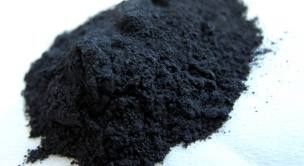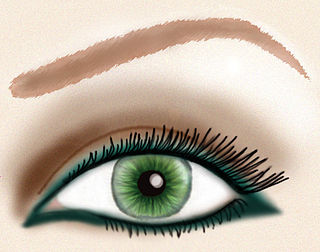
Cosmetics are constituted mixtures of chemical compounds derived from either natural sources, or synthetically created ones. Cosmetics have various purposes. Those designed for personal care and skin care can be used to cleanse or protect the body or skin. Cosmetics designed to enhance or alter one's appearance (makeup) can be used to conceal blemishes, enhance one's natural features, add color to a person's face, or change the appearance of the face entirely to resemble a different person, creature or object. Cosmetics can also be designed to add fragrance to the body.

Mascara is a cosmetic commonly used to enhance the upper and lower eyelashes. It is used to darken, thicken, lengthen, and/or define the eyelashes. Normally in one of three forms—liquid, powder, or cream—the modern mascara product has various formulas; however, most contain the same basic components of pigments, oils, waxes, and preservatives. The most common form of mascara is a liquid in a tube with an application brush.

An eyelash is one of the hairs that grows at the edges of the top and bottom eyelids, spanning outwards and away from the eye. The lashes grow in up to six layers on each of the upper and lower eyelids. Eyelashes serve to protect the eye from debris, dust, and small particles, and are highly sensitive to touch, thus providing a warning that an object is near the eye. The eyelid margin from which lashes grow is among the most sensitive parts of the human body, with many nerve endings enveloping the roots of the lashes, giving it sensitivity to very light tactile input via the lashes, enabling it to trigger the blink reflex when touched. Eyelashes are also an important component of physical attractiveness, with prominent lashes drawing attention to the eyes.

Kohl (Arabic: كُحْل, romanized: kuḥl), Kajal, Kajol, or Tiro is an ancient eye cosmetic, traditionally made by grinding stibnite (Sb2S3) for use similar to that of charcoal in mascara. It is widely used in the Middle East, Caucasus and North Africa, South Asia, West Africa, and the Horn of Africa as eyeliner to contour and/or darken the eyelids and as mascara for the eyelashes. The content of kohl and various ways to prepare it differ based on tradition and country. Several studies have questioned the safety of kohl due to the dangers of lead poisoning.

Permanent makeup, also known as permanent cosmetics, derma-pigmentation, micro-pigmentation, and cosmetic tattooing, is a cosmetic technique which employs tattoos as a means of producing designs that resemble makeup, such as eye-lining and other permanent enhancing colors to the skin of the face, lips, and eyelids. It is also used to produce artificial eyebrows, particularly in people who have lost them as a consequence of old age, disease, such as alopecia totalis, chemotherapy, or a genetic disturbance, and to disguise scars and hypopigmentation in the skin such as in vitiligo. It is also used to restore or enhance the breast's areola, such as after breast surgery.

Rouge, also called blush or blusher, is a cosmetic for coloring the cheeks in a variety of shades, or the lips red. It is applied as a powder, cream or liquid.

Eye liner or eyeliner is a cosmetic used to define the eyes. It is applied around the contours of the eye(s). It is often used to create various aesthetic effects.

Parfums Christian Dior is the perfumery and cosmetics line of the French fashion house, Christian Dior SE. However, the line belongs to the perfumes and cosmetics portfolio of the world's largest luxury group, the LVMH Group. Nevertheless, both Christian Dior SE and LVMH are headed by chairman Bernard Arnault, and Christian Dior SE is the major shareholder of LVMH.

The history of cosmetics spans at least 7,000 years and is present in almost every society on earth. Cosmetic body art is argued to have been the earliest form of a ritual in human culture. The evidence for this comes in the form of utilised red mineral pigments including crayons associated with the emergence of Homo sapiens in Africa. Cosmetics are mentioned in the Old Testament—2 Kings 9:30 where Jezebel painted her eyelids—approximately 840 BC—and the book of Esther describes various beauty treatments as well.

Cosmetics ingredients come from a variety of sources but, unlike the ingredients of food, are often not considered by most consumers. Cosmetics often use vibrant colors that are derived from a wide variety of sources, ranging from crushed insects to rust.

Foundation is a liquid, cream, or powder makeup applied to the face and neck to create an even, uniform color to the complexion, cover flaws and, sometimes, to change the natural skin tone. Some foundations also function as a moisturizer, sunscreen, astringent or base layer for more complex cosmetics. Foundation applied to the body is generally referred to as "body painting" or "body makeup".

Face powder is a cosmetic product applied to the face to serve different functions, typically to beautify the face. Originating from ancient Egypt, face powder has had different social uses across cultures and in modern times, it is typically used to set makeup, brighten the skin and contour the face. Face powders generally come in two main types. One of which is loose powder, which is used to assist with oily skin in absorbing excess moisture and mattifying the face to reduce shininess. The other is pressed powder which conceals blemishes and maximises coverage.

Cosmetics in the 1920s were characterized by their use to create a specific look: lips painted in the shape of a Cupid's bow, kohl-rimmed eyes, and bright cheeks brushed with bright red blush.
Eyelid dermatitis is commonly related to atopic dermatitis or allergic contact dermatitis. Volatile substances, tosylamide, epoxy hardeners, insect sprays, and lemon peel oil may be implicated, with many cases of eyelid contact dermatitis being caused by substances transferred by the hands to the eyelids.

Theatrical makeup is makeup that is used to assist in creating the appearance of the characters that actors portray during a theater production.
Cosmetics, first used in ancient Rome for ritual purposes, were part of daily life. Some fashionable cosmetics, such as those imported from Germany, Gaul and China, were so expensive that the Lex Oppia tried to limit their use in 189 BCE. These "designer brands" spawned cheap knock-offs that were sold to poorer women. Working-class women could afford the cheaper varieties, but may not have had the time to apply the makeup as the use of makeup was a time-consuming affair because cosmetics needed to be reapplied several times a day due to weather conditions and poor composition.
A cosmetic primer is a cream applied before another cosmetic to improve coverage and lengthen the amount of time the cosmetic lasts on the face.

e.l.f. Beauty Inc. is an American cosmetics brand based in Oakland, California. It was founded by Joseph Shamah and Scott Vincent Borba in 2004. Items include bath and skin-care products, mineral-based makeup, professional tools, eyeliners, lipstick, glosses, blushes, bronzers, brushes, and mascara, among others.

The ancient Egyptians regarded beauty as a sign of holiness. Everything they used had a spiritual aspect to it, including cosmetics. Both men and women wore makeup. Traders traded makeup often, especially in the upper classes. In tombs, cosmetic palettes were found buried in gold with the deceased as grave goods, which further emphasized the idea that cosmetics were not only used for aesthetic purposes but rather magical and religious purposes.

A makeup brush is a tool with bristles, used for the application of makeup or face painting. The bristles may be made out of natural or synthetic materials, while the handle is usually made out of plastic or wood. When cosmetics are applied using the appropriate brush, they blend better onto the skin.



















